Llangollen, Wales
How do you pronounce Llangollan? Absolutely nothing like it is spelt – Khlan – gothlen is how the locals pronounce with a guttural intonation.
No matter how it is spelt, the setting of this Welsh country town is picturesque no matter which way you look.
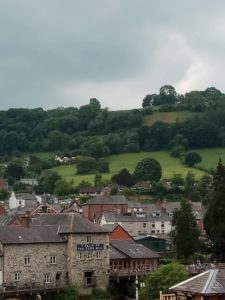 Sitting high above the Dee Valley any vantage point gives you views over green pastures on rolling hills dotted with traditional white cottages, some bigger than others.
Sitting high above the Dee Valley any vantage point gives you views over green pastures on rolling hills dotted with traditional white cottages, some bigger than others.
The town itself is unfortunately on the main thoroughfare of the A5 and the narrow two way main street can be a bit of a traffic jam at times. But the bike riders love it as they wind their way between the stationary cars. I booked this town believing that we would spend a quiet time in a small country town off the beaten track. How wrong we were. Either everyone had the same idea of going there to get away from it all or it is not such a great big secret after all.
One of the great attractions, beside the lovely drive there and great views is the vintage railway and the Llangollen Canal that calmly travels beside the Dee river and it’s rapids, littered with foolhardy canoeists.
We did a tour along this quietly serene canal on a day trip which culminated with a crossing over the Dee Valley on the Pontcysylite Aqueduct. I knew it was tall, but having no railing on one side and a shear drop of 38 metres into the valley below really gave this trip an added bit of excitement to end the day.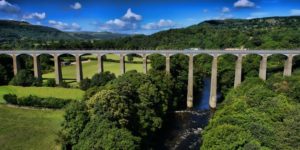
The Pontcysylite Aqueduct is the longest navigable aqueduct in Great Britain and the highest in the world and very busy when we were there. As it is one way, thank goodness there was a line up of boats waiting to cross. But I must admit everyone was very well mannered.
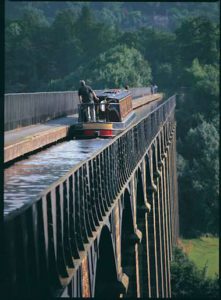
Don’t know that I would do it again and pleased that I wasn’t skippering the boat this time, but happy to be back on board a canal boat. That is one thing that we will definitely do again as soon as we can convince some other silly buggers that it’s really fun going through those locks and opening and closing those gates. I’ll do the skippering maneuvering a 60 feet long steel hull into that narrow lock – that’s the easy part, but don’t tell my unsuspecting passengers.
 When in Llangollen we stayed at the Hand Hotel, another oldy worldy establishment. We’ve got so used to uneven floors, steep stairs (54 in this one), windows that barely open with centuries of paint that we’re not sure what century we are in sometimes.
When in Llangollen we stayed at the Hand Hotel, another oldy worldy establishment. We’ve got so used to uneven floors, steep stairs (54 in this one), windows that barely open with centuries of paint that we’re not sure what century we are in sometimes.

 This town is now a tourist resort and the steam trains carry plenty of Welsh and English tourists as well as us foreigners. The steam engines, of which there are many, were in immaculate condition being rebuilt, driven and serviced by volunteers of all ages. It was so good to see the young guys and girls in there with the older seniors teaching them the ropes.
This town is now a tourist resort and the steam trains carry plenty of Welsh and English tourists as well as us foreigners. The steam engines, of which there are many, were in immaculate condition being rebuilt, driven and serviced by volunteers of all ages. It was so good to see the young guys and girls in there with the older seniors teaching them the ropes.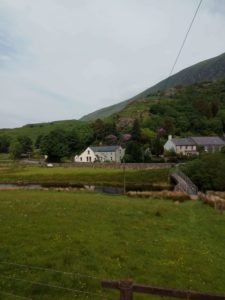
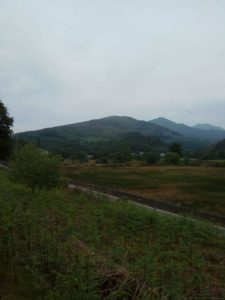 So up and over the range we went on reasonably wide two way roads and dry stone walls stacked on both sides. Some of the towns required pulling over as parked cars made the drive through town one way. But don’t the bike riders love it, both motor and peddles. Being a nice sunny day they were out in force.
So up and over the range we went on reasonably wide two way roads and dry stone walls stacked on both sides. Some of the towns required pulling over as parked cars made the drive through town one way. But don’t the bike riders love it, both motor and peddles. Being a nice sunny day they were out in force.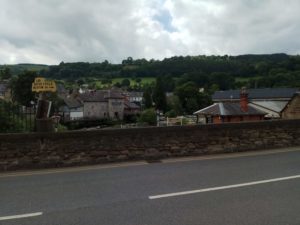 We really knew we had arrived in North West Wales when we come over a rise and were surpised by the instant change of scenery. From lush green hills and valleys to dark grey hills made by slate caste offs from the many slate mines and quarries that this area is renowned for.
We really knew we had arrived in North West Wales when we come over a rise and were surpised by the instant change of scenery. From lush green hills and valleys to dark grey hills made by slate caste offs from the many slate mines and quarries that this area is renowned for.